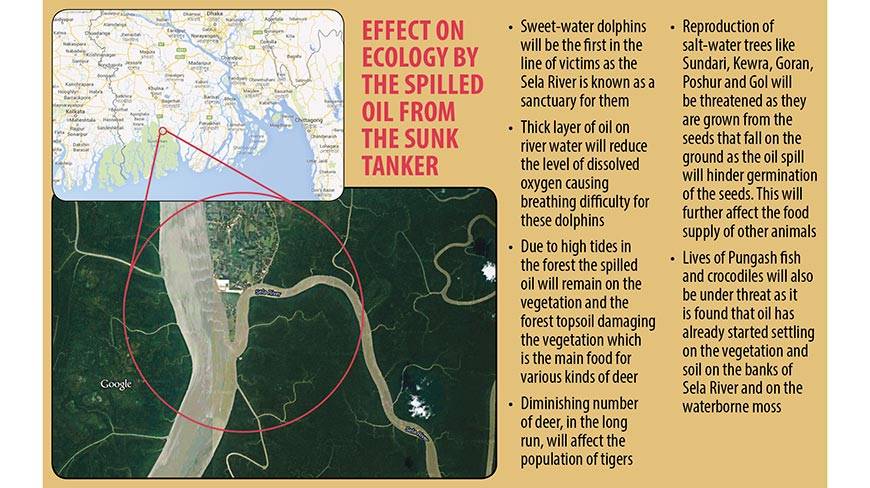Abu Bakar Siddique
The Sundarbans is now facing a major environmental disaster, after a vessel carrying over 350,000 litres of furnace oil capsized in Sela River, as spill
particularly jeopardises a dolphin sanctuary, the local food chain and the entire local ecology.
With various authorities, who neither have the experience nor the capability to handle such a case, trying to pass the responsibility on to each other instead of making a move, the situation is getting worse by the minute since the capsize took place in the early hours yesterday.
As of filing of this report around 15 hours after the incident, no sign of a rescue operation was reported in the area.
“Oil tanker Southern Star Seven was anchored in the river because of dense fog. It capsized around 6am at a place inside the Chandpai Range under West Zone when another empty tanker named MT Southern hit it because of poor visibility,” Amir Hossain Chowdhury, divisional forest officer of the Sundarbans, told the Dhaka Tribune.
When contacted, Md Shafiqul Haq, a director of Bangladesh Inland Water Transport Authority (BIWTA), said rescuing or managing oil tankers is not part of their job description; they only deal with passenger vessels.
When contacted, AKM Fakhrul Islam, chief engineer of the government’s Shipping Department, said their task is only to register vessels and recruit marine crews; hence, rescuing a sinking vessel is not their responsibility.
The route that the capsized vessel took is prohibited for all kinds of large vessels. Researchers and pro-environment groups have for many years been repeatedly warning the government against the use of this route.
Water resources expert Ainun Nishat told the Dhaka Tribune yesterday: “Now is not the time to think which route is legal and which is not. Sundarbans is in big trouble. Our first priority should be preventing the oil spill immediately.”
Ecology in jeopardy
The Sela River is known as a sanctuary for sweet-water Irawaddy and brackish-water Ganges dolphins. So, these marine creatures will be the first in the line of victims of the oil spill.
“They will soon find breathing hard because the thick layer of oil over the river water will reduce the level of dissolved oxygen,” ecology and biodiversity researcher Pavel Partha told the Dhaka Tribune yesterday.
As a coastal mangrove forest, the vegetation in the Sundarbans gets inundated twice a day by high tides. Now that there is oil, as water recedes with low tide, the oil will remain on the vegetation and the forest topsoil.
The vegetation is the main food of various kinds of deer that live in the dense forest surrounding the river. The deer, in turn, is one of the main foods of the Bengal tigers. So, in the long run, the population of deer and tigers – the two best known animals from the Sundarbans – will be affected.
The mangrove ecosystem of Sundarbans is primarily made up of four kinds of salt-water trees: Sundari, Kewra, Goran, Poshur and Gol. These trees reproduce from the windfall seeds that fall on the ground.
As oil settles on the forest topsoil, these seeds will die and in the long run, the regeneration of the Sundarbans will be badly affected. That in turn will put the deer and different types of primates in trouble who depend on these trees for living.
These windfall seeds are the staple food of Pungash fish that also inhabit the Sela waters. This fish again is one of the main foods of crocodiles – a famous reptile from these forests.
If Pungash does not get anything to eat, they will die, eventually putting the lives of crocodiles at risk as well.
Our Khulna correspondent travelled to the troubled part of the forest yesterday afternoon and found that oil has already started settling on the vegetation and soil on the banks of the Sela River and in the moss on the water.
After talking to Giasuddin, owner of the capsized vessel, our correspondent reports that nobody has any idea about when the rescue may begin. Giauddin said his firm Harun and Company had been trying in their way to rescue the vessel.
Sources said the Forest Department does not have the necessary equipment for sucking up the oil from the water; that is why they are now waiting for the owner to pull out the vessel.
Hydrology and environment expert Ainun Nishat urged the government to take immediate steps to remove the vessel instead of playing “pass the cushion.”
He suggested the government may take help from the coastguard or the navy who have the equipment to suck up the oil.
The illegal route
Capsized tanker Southern Star Seven was carrying 357,664 litres of furnace oil to a power station in Gopalganj district from the Khulna oil depot when it capsized yesterday. The physical distance between Khulna and Gopalganj is not very much, but on water, it is a tedious roundabout journey.
The Sela River route that the Southern Star Seven was following is prohibited for all kinds of large vessels because it runs through deep forest and also is the dolphin sanctuary.
Then again, large vessels such as oil tankers do not have any option but to travel on Sela River because the legal route – Mongla-Ghosiakhali-Morelganj – has been unusable for more than three years because of excessive siltation.
The Centre for Environmental and Geographical Information Services (CEGIS), an autonomous body of the Water Resources Ministry, has been trying to press their recommendations to the government for a long time, even before the legal route went fully unusable in 2011. But their recommendations, for keeping the Chandpai dolphin sanctuary in Sela River safe, have never been heeded.
The CEGIS has warned that plying of large vessels in the sensitive channel will result in ecological imbalance in the area by causing sound pollution and riverbank erosion.
Yunus Ali, the chief conservator of forest, said a large number of vessels, more than 500 to be specific, including large barges and oil takers navigate through the deep forest using the Sela route.
He claimed that his department had held several meetings with the BIWTA for finding an alternate route, but without any success.
BIWTA Director Md Shafiqul Haq told the Dhaka Tribune that although passenger vessels sometimes capsized in the Sela River, not a single oil tanker has capsized in the Sundarbans before – not at least in the 30 years that he has been in service.
The Sundarbans
The Sundarbans is a unique habitat for a number of wildlife. Apart from the Bengal tiger, Gangetic and Irawaddy dolphin, primates, Indian fishing cat, Indian otter and spotted deer, many other prominent fauna populate the single biggest mangrove forest in the world.
The Sundarban harbours 334 species of trees, shrubs and epyphites and 269 species of wild animals.
The 1,39,700-hectare forest is a World Heritage Site of the Unesco where three wildlife sanctuaries – Sundarban East, Sundarban West and Sundarban South – are located.
The healthy existence of the forest is absolutely crucial for Bangladesh. In 2007, the Sundarbans, acting as a natural shield, weakened down devastating cyclonic storm Sidr, preventing it from inflicting irrevocable damage in the country.
Source: Dhaka Tribune










